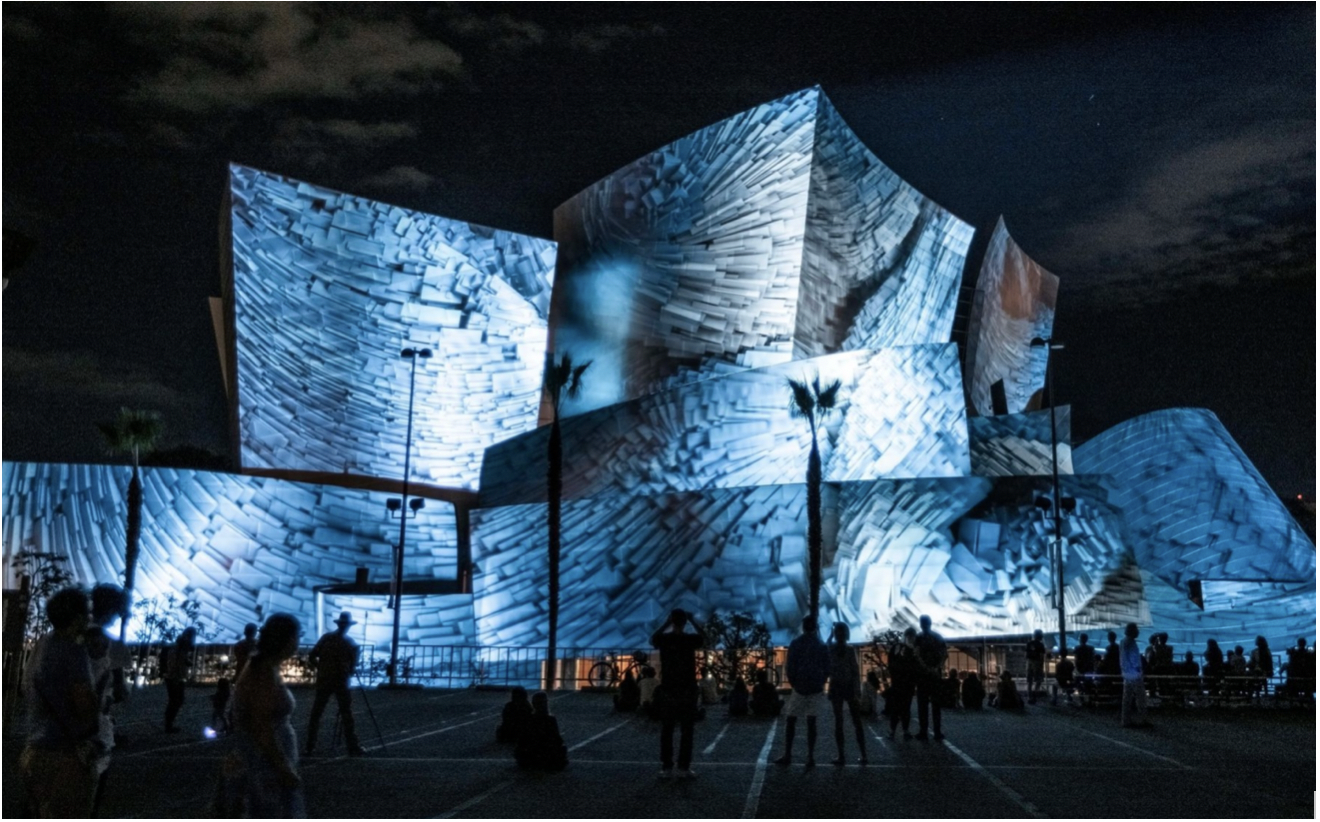Drawing Operations Unit: Generation 2 (Memory)
Sougwen Chung’s piece, Drawing Operations Unit: Generation 2 (Memory), is the second work in her astonishing Drawing Operations Unit Generation series. This work is an electric duet between her and a robot, D.O.U.G. This robotic arm was created working alongside developer, Yotam Mann, in 2015 and has expanded into a series of projects. In this work, the robot utilizes its machine learning process to mimic the gestures Chung completes. The artificial intelligence’s movements are reflections of the computer’s ability to memorize Sougwen Chung’s artistic style. In Generation 1, the robotic arm reacts to what Chung sketches and makes real-time movements and decisions. Generation 2 goes much further and learns from Chung’s style and past movements. This work is composed of flowy lines and organic movements. The final product is a filled canvas of vivid blues and graduated light shading that adds a unique depth effect and many chaotic and free lines that spiral into a magnificent epicenter. The overall feeling of the final product is calming, tranquil and oceanic. This work appears to be flower-like in structure. One would not guess that this was a work that was created in part by a robot with the ability to learn the human artists' style.
This collaboration between a human, Sougwen Chung, and robot, D.O.U.G, is a beautiful representation of bringing the past and present together. The new technology of D.O.U.G, developed by Yotam Mann, in combination with classic paper and pencil sketching is an innovative take on artificial intelligence and the future of how humans can work with technology and bring technological advancements to the art space. With the rapid increase of artificial intelligence development over that last decade, Chung’s work is timely and provides insight into alternate uses of emerging technology.
Many people see artificial intelligence solely as robots that are taking all of the jobs available and removing the need for human intervention in many work environments. Sougwen Chung and other emerging artists utilize these technological advancements to benefit their art and work parallel to these modern innovations.
““In this age of remarkable developments in artificial intelligence related technologies, AI is increasingly being considered as a danger to human employment. This anxiety is based on the understanding of man and machine as opposing elements.””
Generation 1 one of the Drawing Operations Unit Series focused primarily on the real-time drawing movements and tested the bounds of human-robot collaboration. As Chung developed this project further she tested machine learning, not just basic real-time motions. Through a technological lens, D.O.U.G 2, is far more advanced than D.O.U.G 1. Generation 2 has the heightened ability to train over time. The unique neural nets of this piece are trained over time and practice based on the gestures that Chung creates while drawing. The machine learning feature is truly stunning and allows for the growth of the relationship between Chung and her robotic art partner as well as further advancements in her artistic endeavors.
In the same vein as Chung, Pindar Van Arman works with new media, artificial intelligence, paint, and canvas to create art in collaboration with advanced technology. Van Arman codes and programs robots and teaches them to paint in the style of famous artists and recreate masterpieces. He studies the work of great artists such as Paul Cezanne, Van Gough, Picasso, Andy Warhol, and de Kooning. He has built multiple creative robots that paint works of art that are indistinguishable from the work of humans. While Chung works alongside her robot, Van Arman builds the robots and lets them complete the paintings free from his intervention.Artificial Intelligence is often thought of as cold and lifeless but Pindar Van Arman and Sougwen Chung are shifting this paradigm as they break through to the creative artistic possibilities that lie within the wonderful world of AI.
Image courtesy of Vice News, https://www.youtube.com/watch?v=dkTjEi7O4Ic
Another artist who analyzes the collaboration between humans and artificial intelligence is Lauren McCarthy. This artist delves into human interaction with AI and how this technology, while it has flaws, is put in place to help humans through their lives. Her piece, Lauren, where she takes on the role of a human version of Amazon’s Alexa, is an interesting take on AI and human interactions. In this piece, Lauren can offer human answers to real human questions. For example, Lauren can give real advice regarding human problems while Alexa does not have that ability although she is quick to play a certain song when prompted. Her interactive performance piece begs the question, can artificial intelligence recognize human emotions and help humans the way an actual human can? Much like the work of Sougwen Chung, McCarthy questions the relationship between humans and AI.
In the midst of the hectic competition between artificial intelligence and humans seeking careers, the work of Sougwen Chung is a breath of fresh air. Her unique art style in partnership with a memory-driven robot is forward thinking and has the ability to expand into new realms.
Intercommunication Center, 2017
References:
http://sougwen.com/Drawing-Operations-Unit-Generation-2-Memory
http://www.ntticc.or.jp/en/archive/works/drawing-operations-unit-generation-2-memory/
https://qz.com/1023493/ai-will-be-the-art-movement-of-the-21st-century/
http://observer.com/2017/09/lauren-mccarthy-amazon-alexa-google-home/






